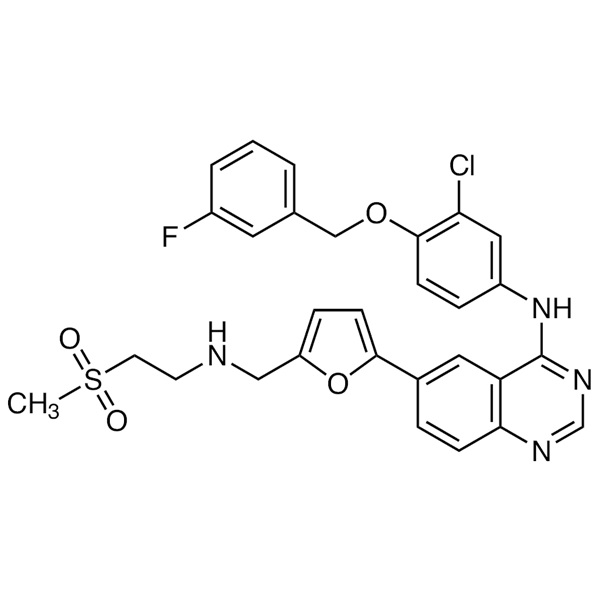Lapatinib Base CAS 231277-92-2 Purity ≥99.0% (HPLC)
| Chemical Name | Lapatinib Base |
| Synonyms | Lapatinib; N-[3-Chloro-4-[(3-fluorobenzyl)oxy]phenyl]-6-[5-[[(2-(methylsulfonyl)ethyl]amino]methyl]furan-2-yl]quinazolin-4-amine; N-[3-Chloro-4-[(3-fluorobenzyl)oxy]phenyl]-6-[5-[[[2-(methylsulfonyl)ethyl]amino]methyl]-2-furyl]-4-quinazolinamine |
| CAS Number | 231277-92-2 |
| Stock Status | In Stock |
| Molecular Formula | C29H26ClFN4O4S |
| Molecular Weight | 581.06 |
| Melting Point | 141.0~149.0℃ |
| Density | 1.381±0.06 g/cm3 |
| COA & MSDS | Available |
| Brand | Ruifu Chemical |
| Item | Specifications |
| Appearance | Almost White or Light Yellow Crystalline Powder |
| Identification | IR; HPLC |
| Purity / Analysis Method | ≥99.0% (HPLC) |
| Melting Point | 141.0~149.0℃ |
| Loss on Drying | ≤0.50% |
| Residue on Ignition | ≤0.10% |
| Heavy Metals (as Pb) | ≤20ppm |
| Organic Volatile Impurities | Meet the Requirement |
| Related Substances | |
| Single Impurity | ≤0.30% |
| Total Impurities | ≤1.00% |
| Test Standard | Enterprise Standard |
| Shelf Life | 2 Years When Properly Stored |
| Usage | API, An Oral Treatment for Breast Cancer |
Package: Bottle, Aluminium foil bag, 25kg/Cardboard Drum, or according to customer's requirement
Storage Condition: Store in sealed containers at cool and dry place; Protect from light and moisture


API (CAS: 231277-92-2) is a targeted therapy of breast cancer drug, is a tyrosine kinase inhibitor, can effectively inhibit the human epidermal growth factor receptor -1 (ErbB1) and human epidermal growth factor receptor (ErbB2) tyrosine kinase activity of -2. It is unique in that it can play a role in a variety of ways, so that breast cancer cells can not receive the signal needed for growth. The mechanism of action is to inhibit the intracellular EGFR (ErbB-1) and HER2 (ErbB-2) ATP sites to prevent phosphorylation and activation of tumor cells, and to block the down-regulation of signaling by EGFR (ErbB-1) and HER2 (ErbB-1) homogeneous and heterogeneous two aggregates. The combination of (CAS: 231277-92-2) with Capecitabine is used to treat patients with advanced or metastatic breast cancer with overexpression of human epidermal receptor2, already treated with anthracyclines, paclitaxel, and trastuzumab. Clinical trials have shown that it also effectively treats HER2-type cancer patients with Herceptin resistance.
Lapatinib in combination with Capecitabine is suitable for the treatment of advanced or metastatic breast cancer patients with HER2(ErbB-2 overexpression) and previous treatment including anthracyclines, paclitaxel and trastuzumab.
In vitro Lapatinib tablets can inhibit CYP3A4 and CYP2C8 at therapeutic concentrations, and are mainly metabolized by CYP3A4. drugs that inhibit this enzyme activity can significantly increase the blood drug concentration of Lapatinib. Ketoconazole, 0.2g each time, 2 times/d, can increase the AUC of Lapatinib by 3~7 times and prolong the half-life by 1.7 times after 7 days. Healthy volunteers took CYP3A4 inducer orally, 100 mg each time, twice a day, and changed to 200mg each time after 3 days, sharing 17 days twice a day. AUC of Lapatinib decreased by 72%. Lapatinib is a transport ground for P-glycoprotein, and drugs that inhibit glycoprotein may increase the blood concentration of the drug.
Lapatinib is a new drug for targeted therapy of breast cancer developed by GlaxoSmithKline, UK. It is a tyrosine kinase inhibitor that can effectively inhibit human epidermal growth factor receptor -1(ErbB1) and human epidermal growth factor receptor -2(ErbB2) tyrosine kinase activity. It is unique in that it can function in a variety of ways so that breast cancer cells cannot receive the signals needed for growth. The mechanism of action is to inhibit the ATP sites of EGFR(ErbB-1) and HER2(ErbB-2) in cells to prevent phosphorylation and activation of tumor cells, and block down-regulation signals through homogenous and heterogeneous dimers of EGFR(ErbB-1) and HER2(ErbB-1). Molecular targeted therapy for breast cancer refers to the treatment of oncogenes and related expression products related to the occurrence and development of breast cancer. Molecular targeted drugs inhibit or kill tumor cells by blocking signal transduction in tumor cells or related cells to control changes in cell gene expression. on March 14, 2007, the U.S. food and drug administration approved the combination of lapatinib and xeloda (capecitabine) for the treatment of advanced or metastatic breast cancer patients overexpressed by human epidermal factor receptor 2(ErbB2) and treated with anthracyclines, paclitaxel and trastuzumab. Clinical trials show that this product also has good clinical effects for HER2 breast cancer patients who have developed drug resistance to Roche's Herceptin (Herceptin). lapatinib is a new targeted anticancer drug. It can act on Her-1 and Her-2 targets at the same time. The biological effect of this mode of action on the proliferation and growth of tumor cells is far greater than that of only one target. The so-called targeted therapeutic drugs refer to drugs that use certain receptors, genes or key proteins as targets to kill related tumor cells in a targeted manner.
-
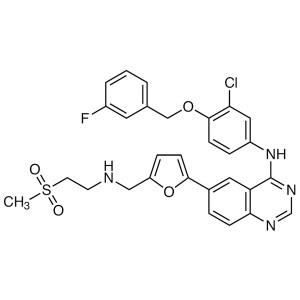
Lapatinib Base CAS 231277-92-2 Purity ≥99.0% (H...
-
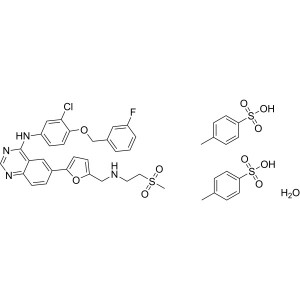
Lapatinib Ditosylate Monohydrate CAS 388082-78-...
-
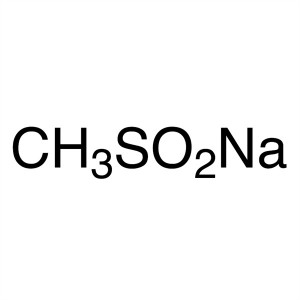
Sodium Methanesulfinate CAS 20277-69-4 Purity >...
-
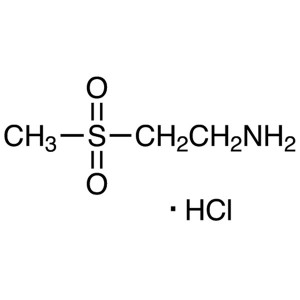
2-Aminoethyl Methyl Sulfone Hydrochloride CAS 1...
-
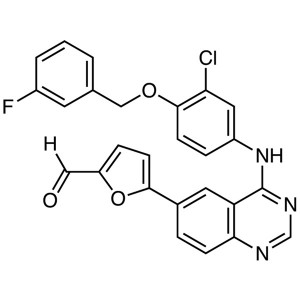
Lapatinib Intermediate CAS 231278-84-5 Purity >...
-
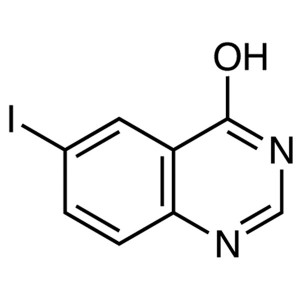
6-Iodo-4-Hydroxyquinazoline CAS 16064-08-7 Puri...
-
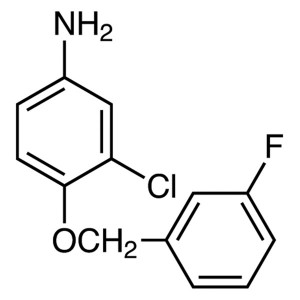
3-Chloro-4-(3-Fluorobenzyloxy)aniline CAS 20219...
-
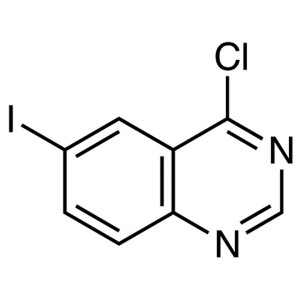
4-Chloro-6-Iodoquinazoline CAS 98556-31-1 Purit...
-
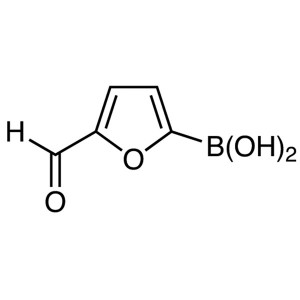
5-Formyl-2-Furanboronic Acid CAS 27329-70-0 Pur...

